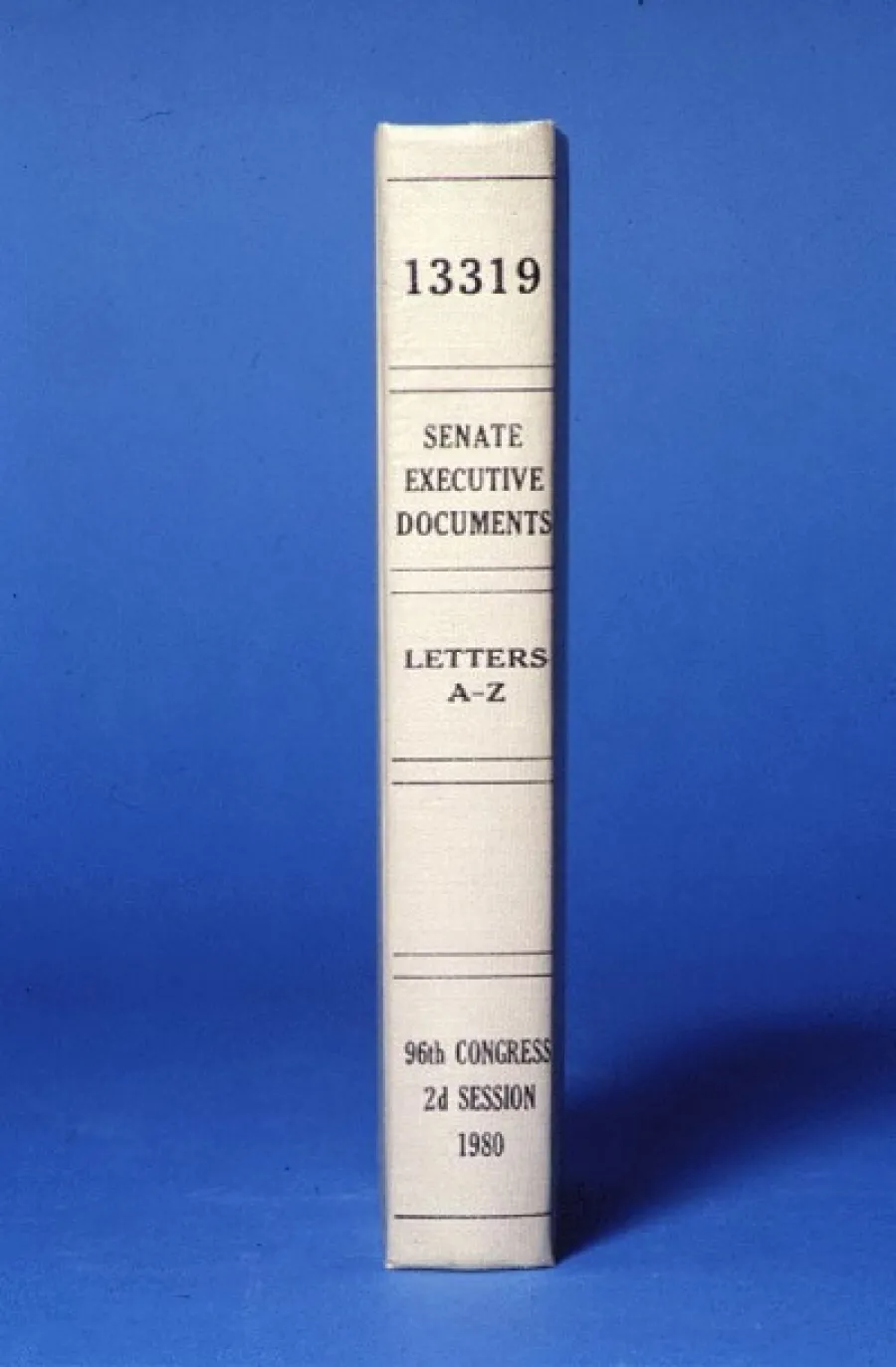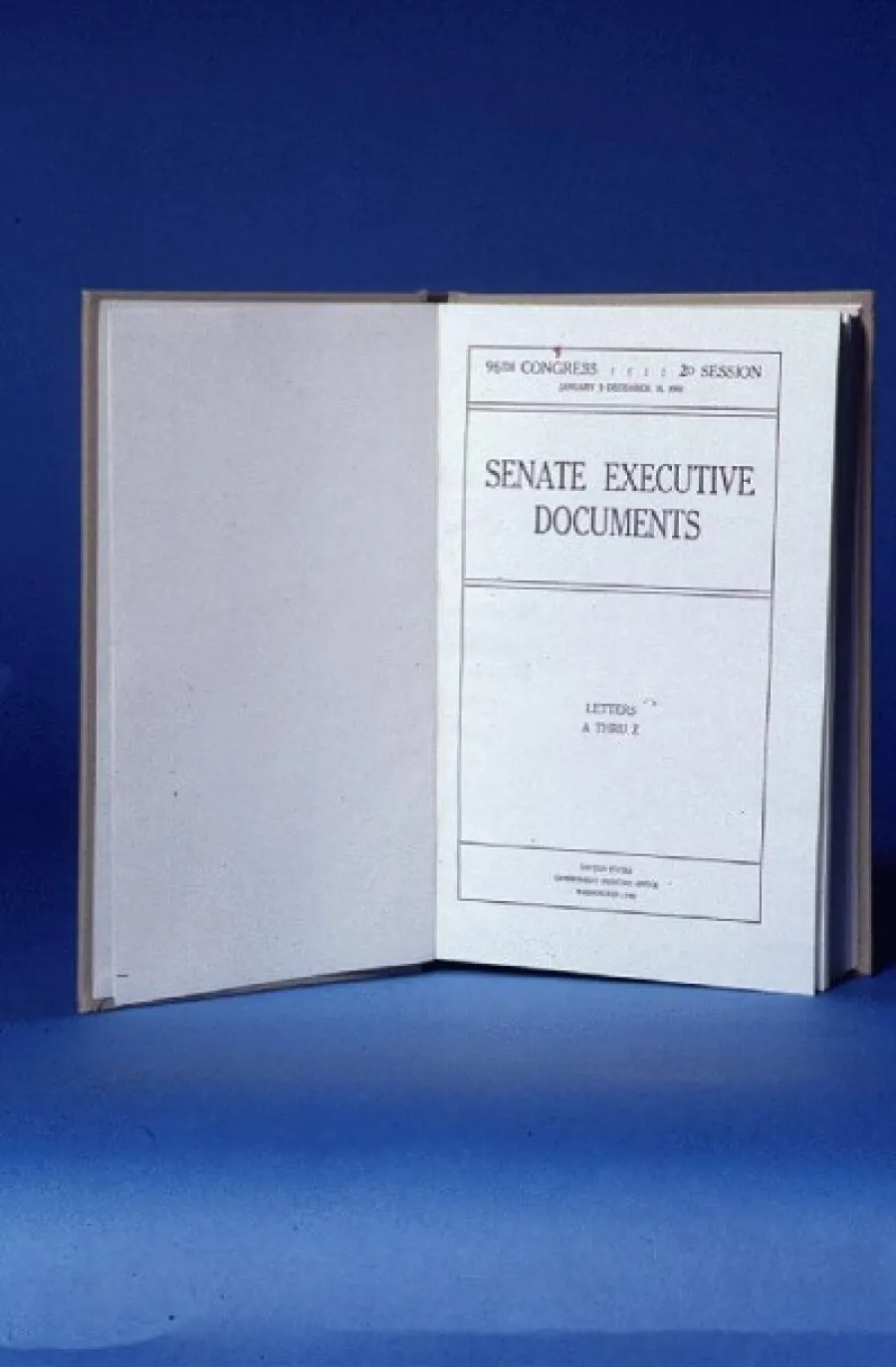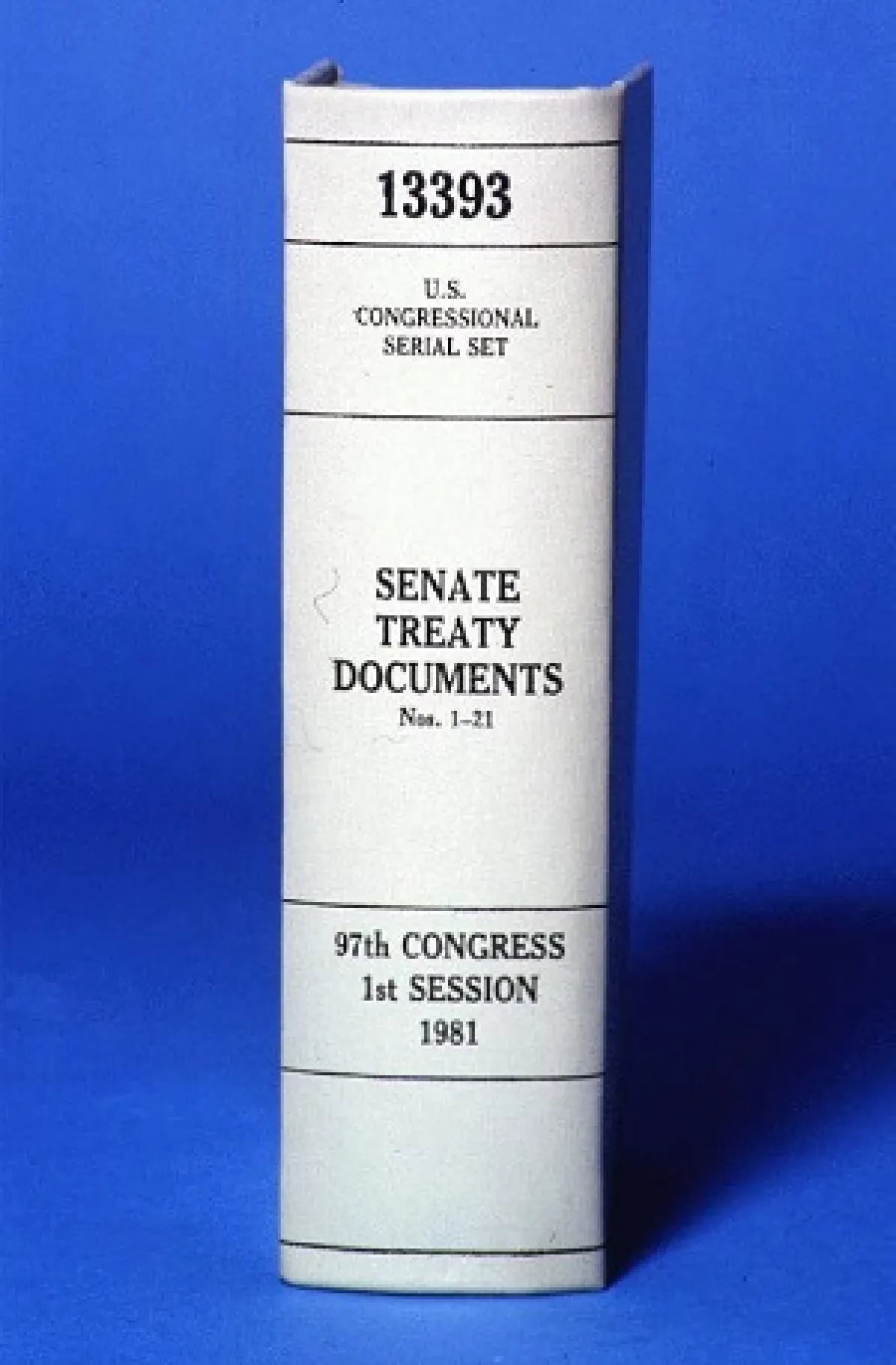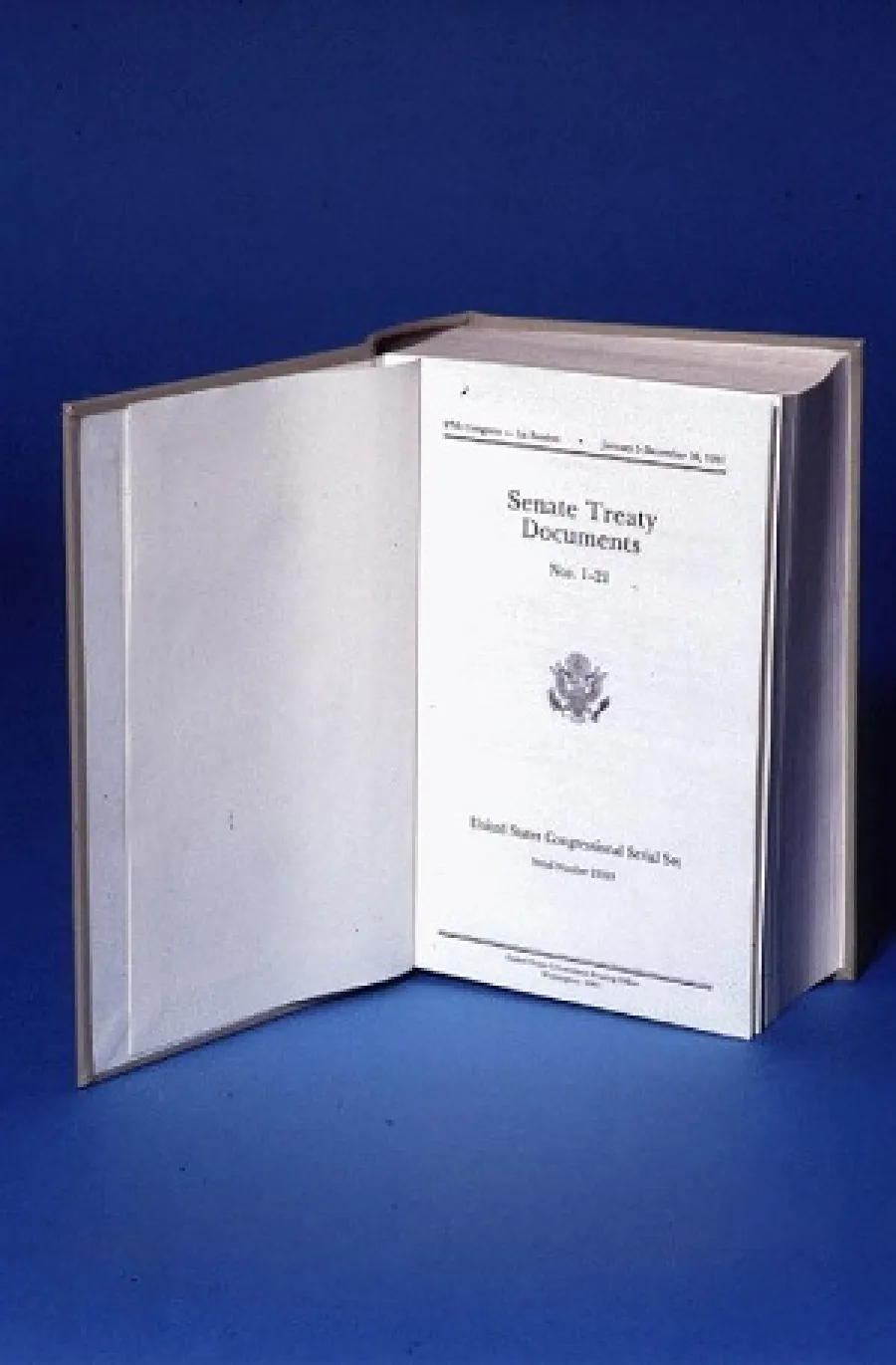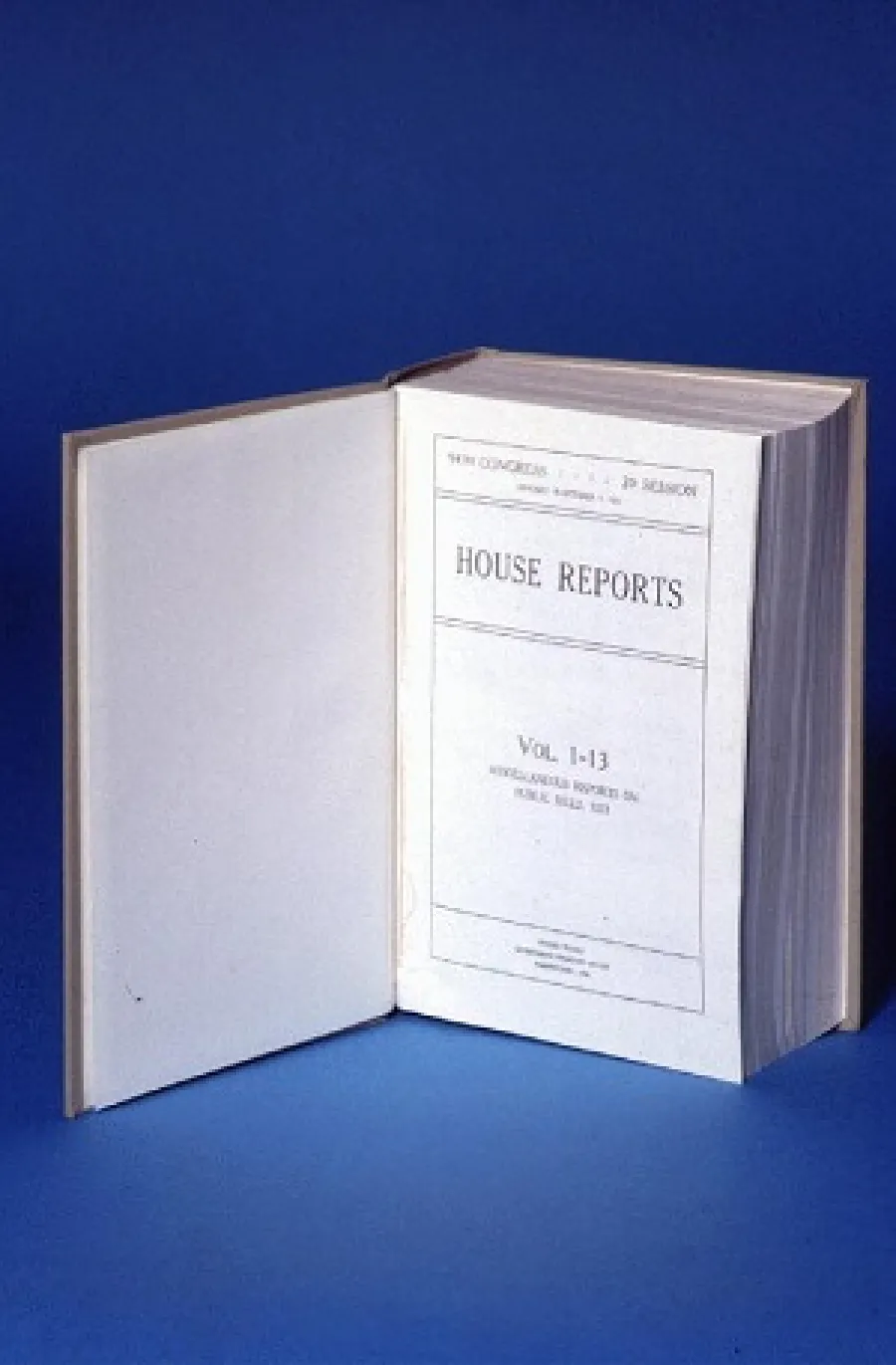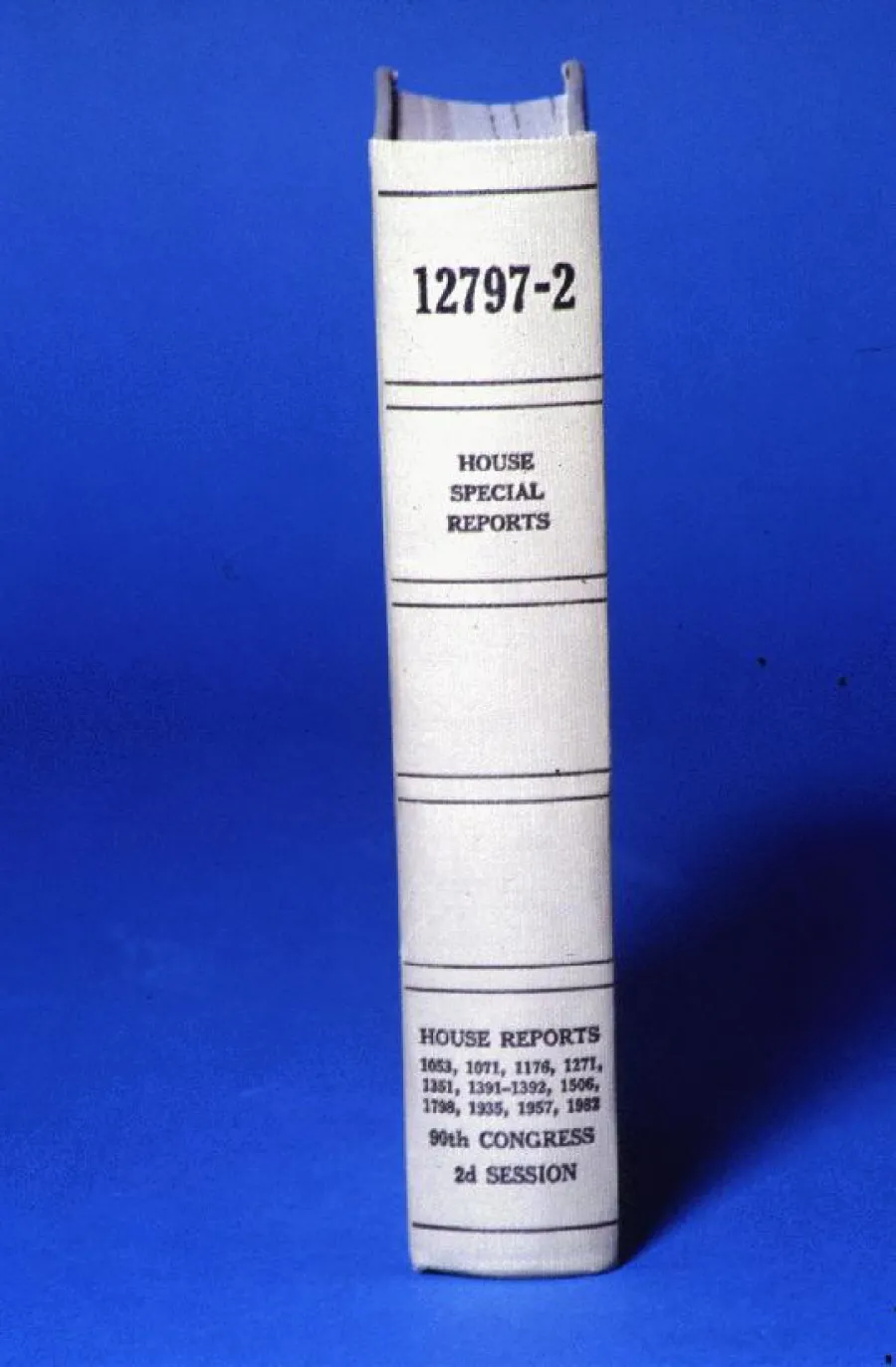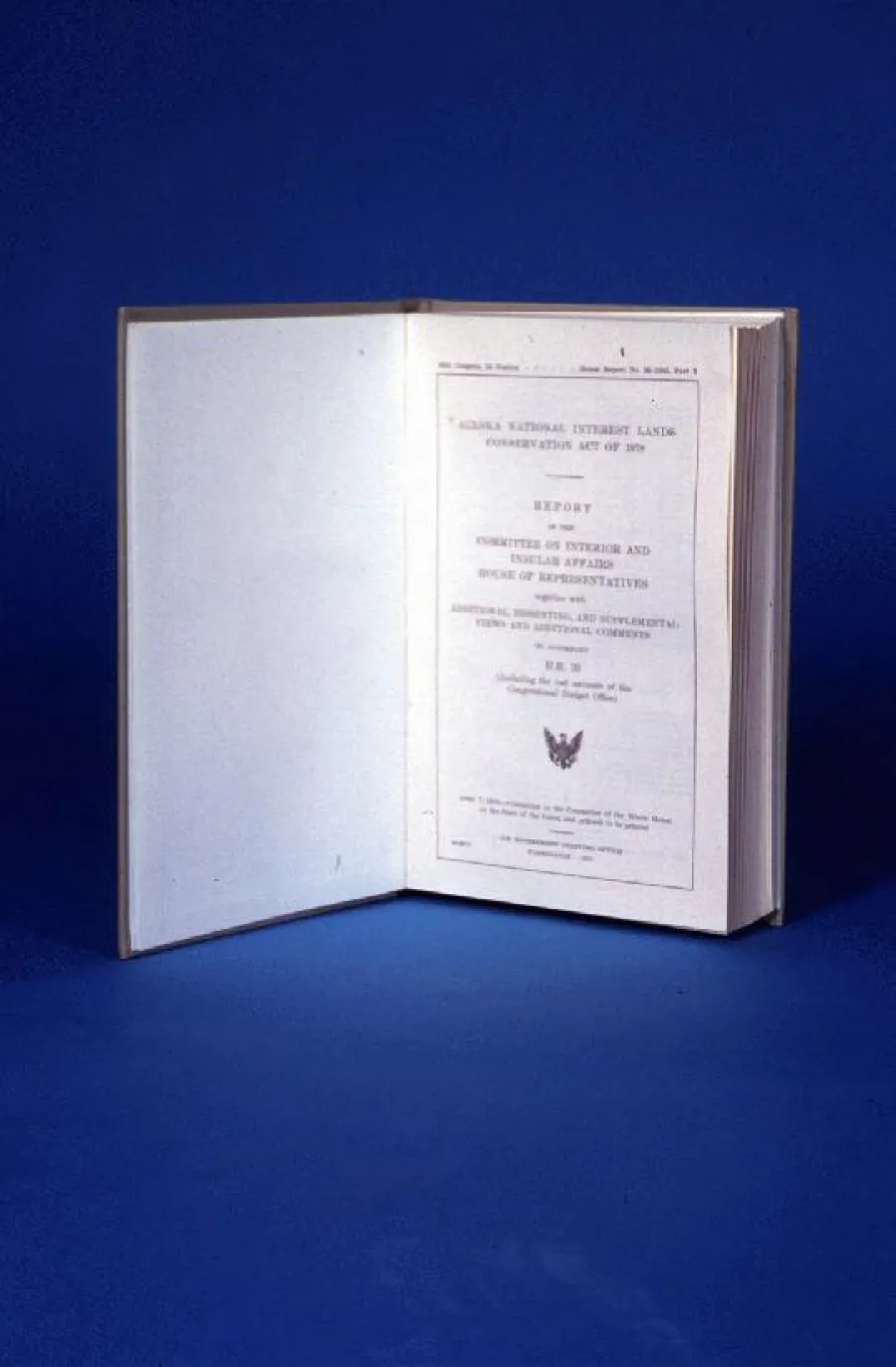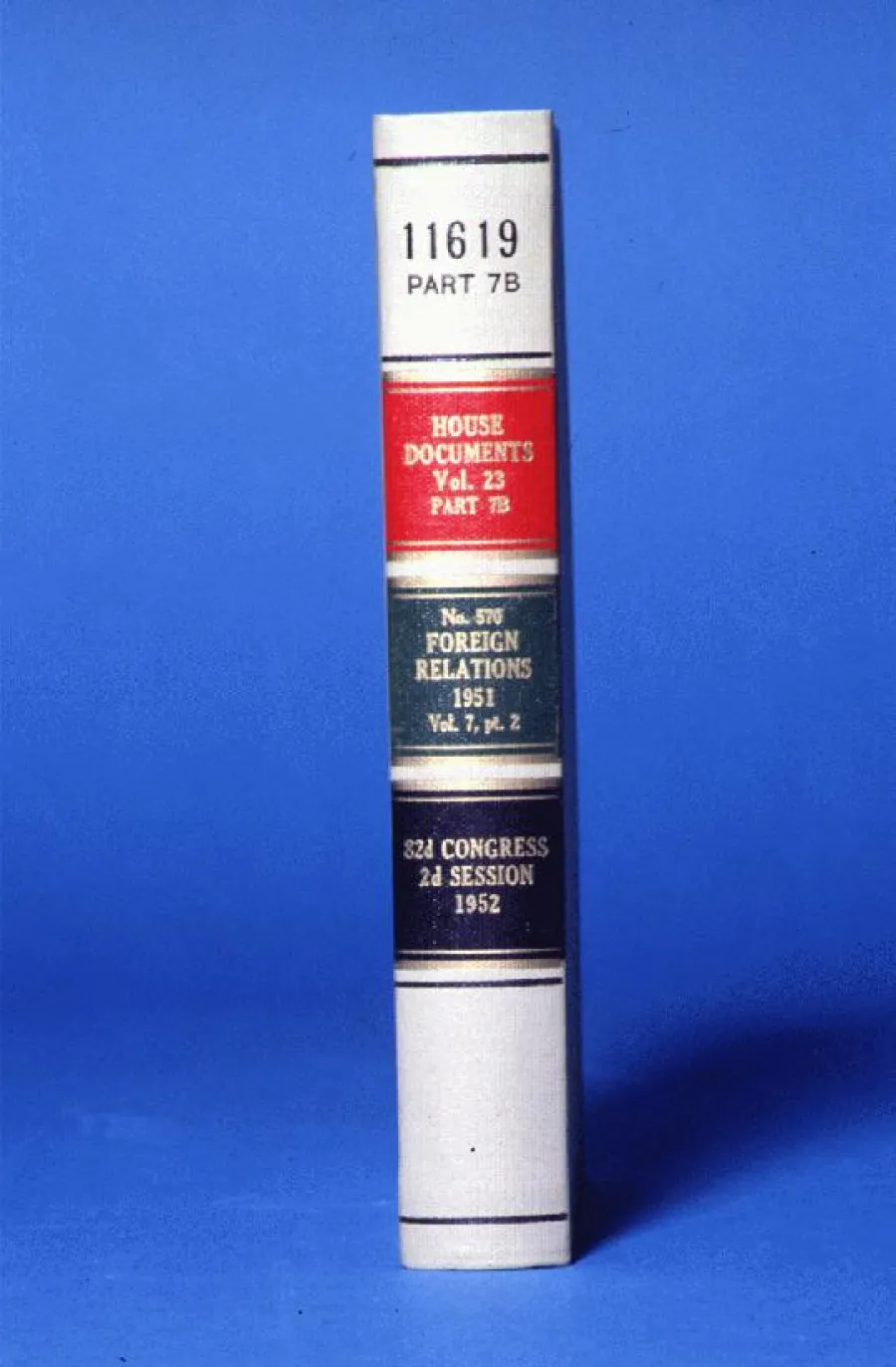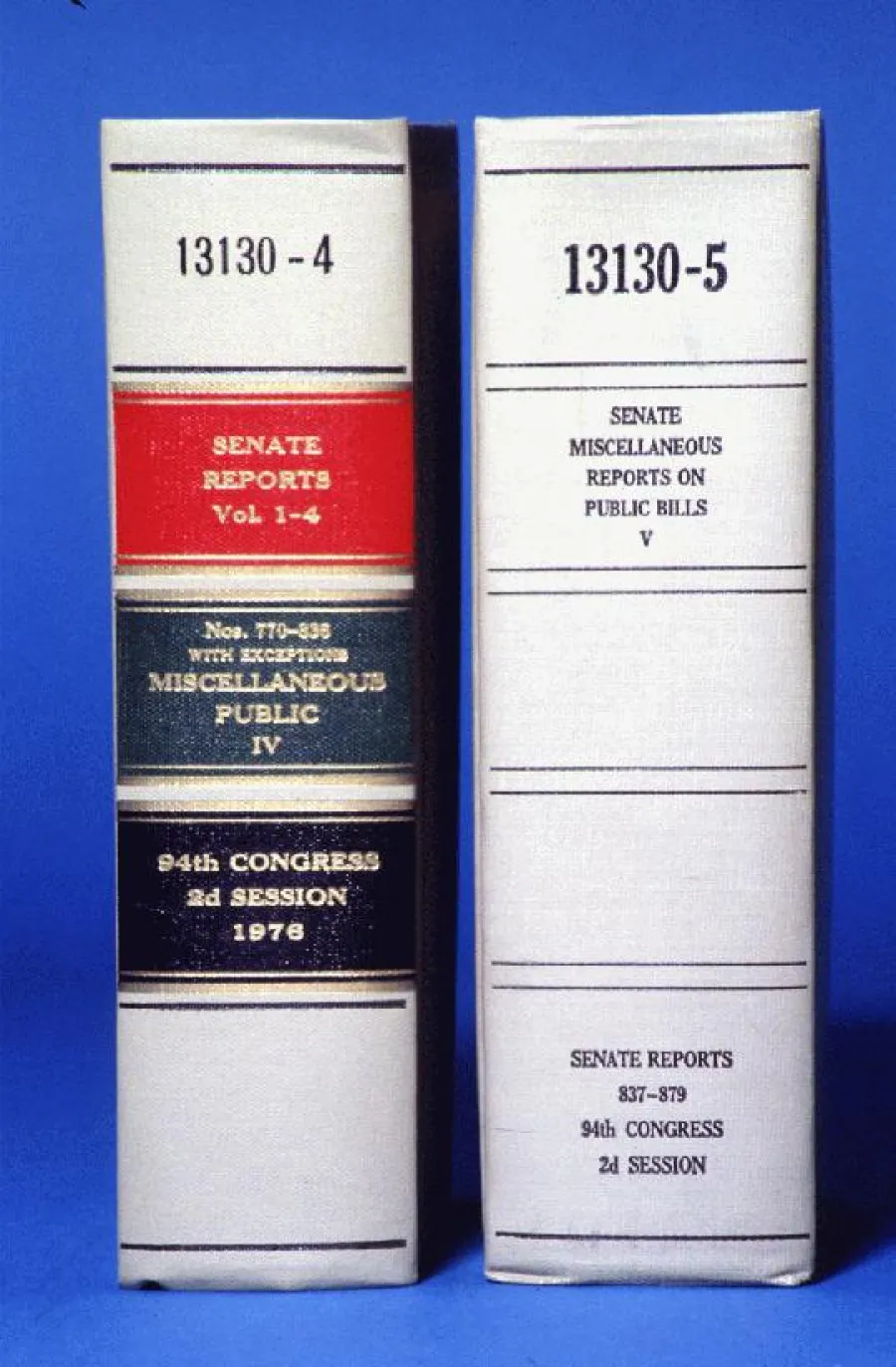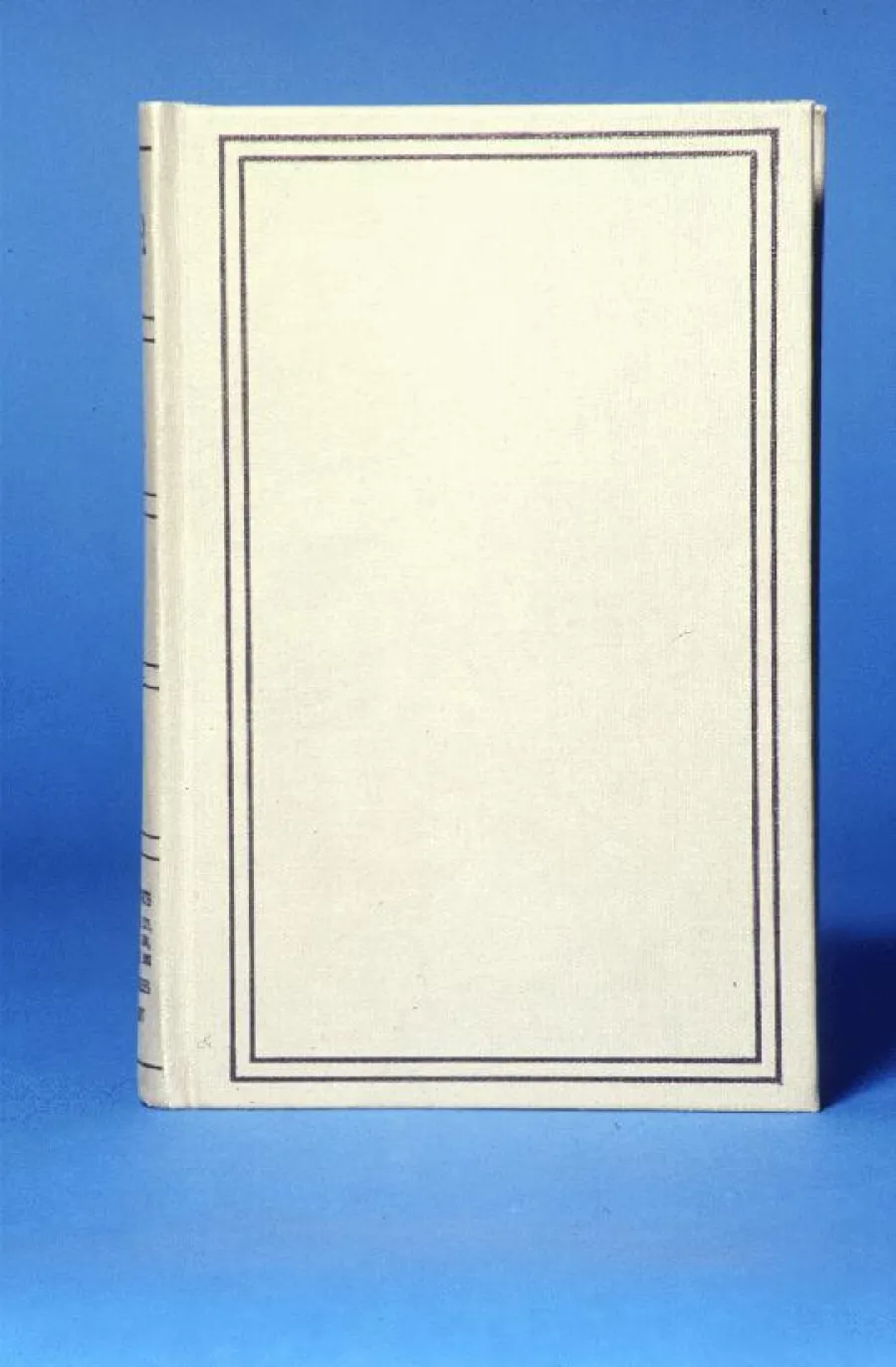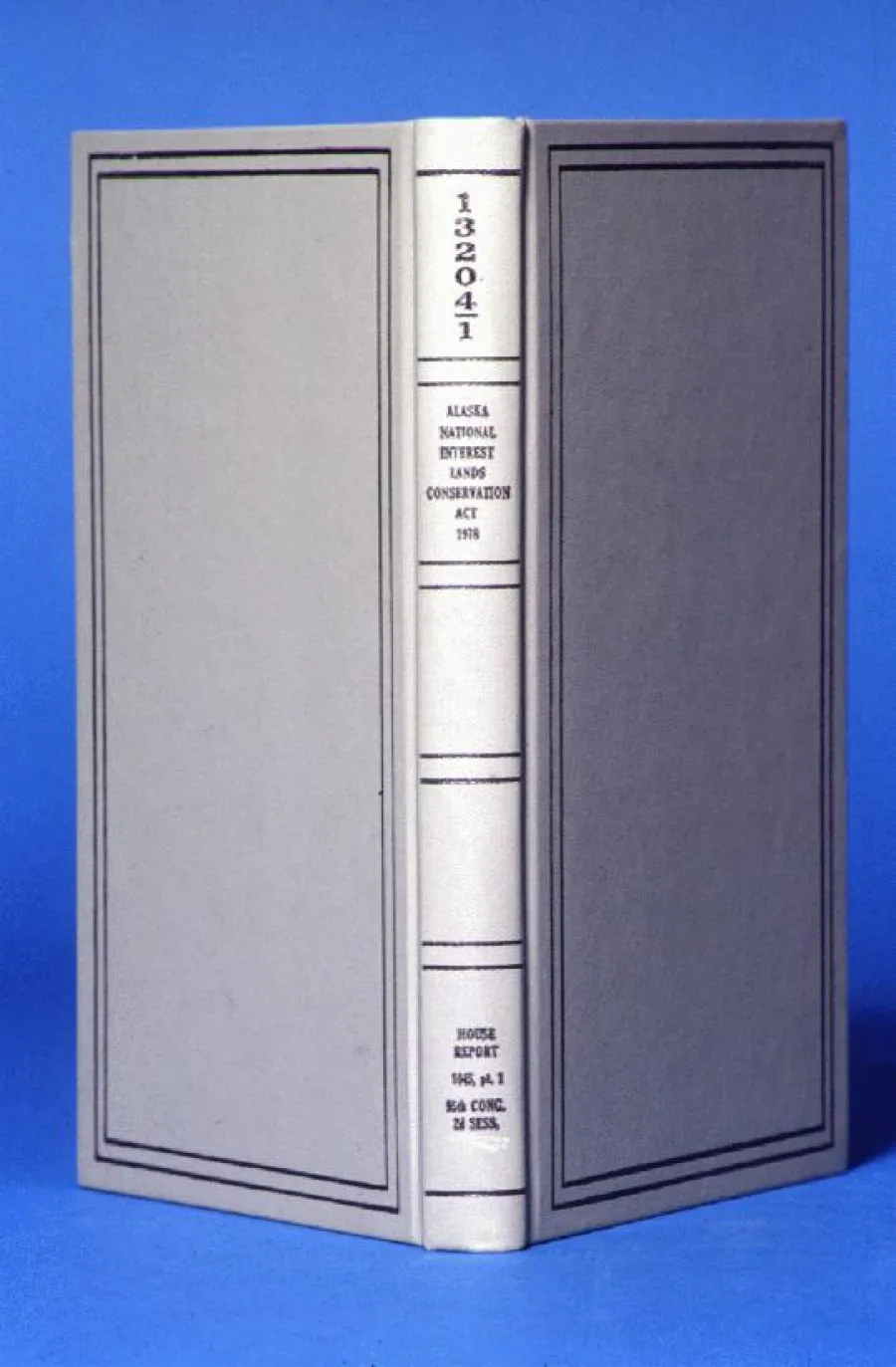Introduction
This is an article was reposted from the retired GPO Access website. The article comprises of excerpts that were adapted from a presentation by Ms. Virginia Saunders, who was a Congressional Documents Specialist, in GPO's Congressional Printing Management Division. Her presentation was given at the Spring 1998 Depository Library Council/Federal Depository Conference in Arlington, Virginia.
I trust that many of you are in some way familiar with the United States Congressional Serial Set, or at least have heard of it. The United States Congressional Serial Set is considered a "must" for a law library or any library which is frequented by law students or legal advisers.
Basically, the "United States Congressional Serial Set," as it is known today, is comprised of the numbered Senate and House Documents and Senate and House Reports which are bound by Session of Congress. The Senate Executive Documents and Senate Executive Reports were also included in the Serial Set at the direction of the Joint Committee on Printing in 1979, beginning with the 96th Congress. Since that time, the Senate Executive Documents, which were previously "alphabetically lettered," became Senate Treaty Documents in 1981, beginning with the 97th Congress, and they are now numbered. All of the above series begin with Number 1 at the beginning of the Congress and are numbered consecutively from the 1st Session through the 2d Session of the Congress.
Under provisions of Title 44 of the United States Code, section 738, the Public Printer is authorized to bind a sufficient number of copies of the Senate and House Documents and Reports and deliver them to the Superintendent of Documents for distribution to "State libraries and other designated depositories for their permanent files." The Public Printer is also authorized to bind Documents and Reports in reserve volumes for the so-called "posterity libraries." These libraries are the Senate and House Libraries, the Library of Congress, the National Archives Library, and the Superintendent of Documents Library collection which is now housed at the National Archives.Under provisions of Title 44 of the United States Code, section 738, the Public Printer is authorized to bind a sufficient number of copies of the Senate and House Documents and Reports and deliver them to the Superintendent of Documents for distribution to "State libraries and other designated depositories for their permanent files." The Public Printer is also authorized to bind Documents and Reports in reserve volumes for the so-called "posterity libraries." These libraries are the Senate and House Libraries, the Library of Congress, the National Archives Library, and the Superintendent of Documents Library collection which is now housed at the National Archives.
The volumes are arranged and bound in the manner directed by the Joint Committee on Printing. Each volume is assigned a Serial Number for identification purposes. The Serial Numbering System which we use today was devised by Dr. John G. Ames, who was at one time in charge of the Documents Division of the Interior Department. It began with the 1st Session of the 15th Congress in 1817, and the numbers have run consecutively ever since that time. The material issued for the first 14 Congresses by both Houses of Congress was merely a series of folio documents to which no number or other distinctive symbol of identification was affixed. Therefore, it was not possible to adopt them into the Serial Numbering Plan. However, in order to make them compatible with the present numbering system, they have been assigned a separate set of numbers preceded by a zero. As many of you perhaps know, this material is known as "The American State Papers." The Serial Numbering Plan has proved to be an orderly and convenient manner by which to identify and preserve for posterity the vast number of individual Documents and Reports issued by the United States Congress.
For 166 years the bound volumes of Documents and Reports had no official title. They were known only by various "popular titles" such as:

- the "Congressional Set" or "Congressional Series," because the volumes are made up of Congressional material
- the "Sheep Set," because at one time the volumes were bound in beautiful sheep leather, which unfortunately did not withstand the ravages of time unless it was specially treated periodically (this binding was used through the 59th Congress, which ended March 1907);
- The "Serial Number Set," because the volumes are identified by a Serial Number which is assigned to and appears at the top of the spine of each volume in the Set.
Finally, in 1981, beginning with the 97th Congress, the volumes were given the official title of "United States Congressional Serial Set." New stamping and new title pages were designed to indicate this "official title."
I might add here that prior to the enactment of the Printing Act of 1895, the Documents Division was under the Department of the Interior. With the enactment of the Printing Act of 1895, the functions were transferred to the Government Printing Office, where they remain to this day.
Scope of Content, What was Included in the Serial Set
For some time now, only the reports of Congressional Committees have been included in the Congressional Serial Set. These reports deal with proposed legislation and contain findings on matters under investigation. Sometimes the reports do contain excerpts from testimony given before Congressional Committees, but normally this material is printed in separate form as "hearings." Under provisions of Title 44, Hearings can only be printed as Congressional Numbered Documents when specifically ordered by Congress. The documents include all other material ordered printed by both Houses of Congress. This material once included many reports of executive departments and agencies. Some of these reports were submitted in accordance with Federal law, while some resulted from resolutions requesting information from executive officers. Some were published in the series merely because at one time a specified number of each document printed was made available for distribution by Members of Congress. However, in an effort to reduce costs, and where there is no definite statutory authority to be complied with, this practice has been discontinued. Congressional printing has been drastically reduced.
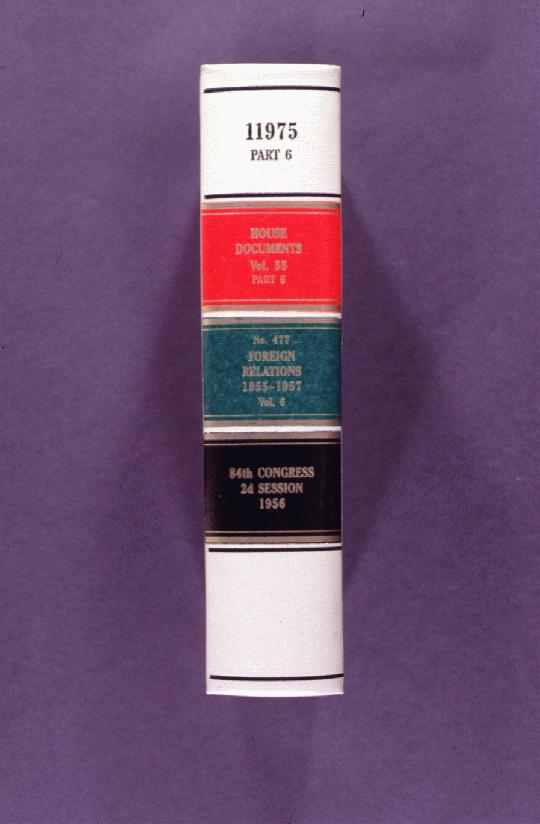
At one time such departmental publications as the Labor Statistics Bureau Bulletins, the Geological Survey Bulletins, the Water Supply Papers, the Minerals Yearbook, the Agriculture Yearbook, the Statistical Abstract of the United States, the Pocket Data Book, Foreign Commerce and Navigation of the United States, American Ethnology Bureau Bulletins, Foreign Relations Papers, and annual reports of many of the Government agencies were all printed as numbered Congressional Documents and included in the Congressional Serial Set. Foreign Relations Papers were assigned a Document Number and bound as part of the Serial Set from 1861 through 1957.
The Senate and House Journals were also bound as part of the Set. This practice was discontinued at the beginning of the 83d Congress, since the statutes provided only for the binding of Senate and House Reports and Senate and House Documents in the reserve sets and the Journals did not fall within that category.
For a time the Public Reports and the Private Reports were bound in separate volumes. There were also volumes entitled "Special Reports," which contained reports on a subject and did not accompany legislation.
How the Serial Set Was Bound
Miscellaneous documents and reports are cumulated into a group approximately 2 1/2 inches in depth before being sent for binding. On occasion it has been necessary to make volumes larger or smaller in depth for various reasons. We feel that volumes larger than 2 1/2 inches in depth are difficult for the user to handle when doing research. Large publications and "odd size" publications are bound individually and receive their respective titles.
Title pages were not always used in the volumes, but the present practice is to include a title page and a table of contents in each volume containing more than one Document or Report.
The Serial Set Is bound in very limited quantity. This is why it is so difficult to replace a lost or missing volume.
Prior to the 96th Congress, which began in January 1979, the "complete" Congressional Serial Set was not sent to depository libraries and International Exchange libraries.Only 22 copies of the "complete" Serial Set were bound. This edition was bound in a more elaborate binding and was, and is, an impressive looking set of books. It was also expensive to produce because the gold stamping and colored ink labels on the spine were all hand work. The copies were distributed to the so-called "posterity libraries" which, as I mentioned earlier, are the Senate and House Libraries, the Library of Congress, the National Archives Library, and the Superintendent of Documents Library collection, which is now housed at the National Archives.
For more information on how the Serial Set was Bound, please Click Here.
Various Editions and Cost Considerations
The edition which the Depository and International Exchange Libraries received contained only publications of which Congress was the author. This edition was bound in a very plain binding, with black ink stamping, which was less expensive to produce. Departmental publications which originated in the various departments, bureaus, and independent establishments of the Government were sent to depositories in the binding used by the agency issuing them, provided that prior to printing, the library had selected the series governing their distribution.
All Congressional material is printed on what we call a 5-digit jacket, such as (55-213). Most of the Congressional material is printed "in house," since the main purpose of establishing the Government Printing Office was to print for Congress.
A star preceding a 5-digit jacket number is a symbol used by the Government Printing Office to indicate a "corrected print." It is commonly referred to as a "star print" and takes precedence over the original print of a Report or Document. Likewise, a double star print takes precedence over a single star print. Whenever a "star print" is printed, that print is bound into the Congressional Serial Set.
Much has been done through the years to reduce the cost of the Congressional Serial Set.
In 1979 the Congressional Serial Set Committee was established as an advisory committee to the Joint Committee on Printing. The Serial Set Committee was composed of representatives from the various major user libraries of the Serial Set. The objectives of the Committee were to improve the physical makeup of the Congressional Serial Set, to reduce the production cost of the Set, and to provide better access to material contained in the Set.
In an effort to reduce the cost of producing the Congressional Serial Set and beginning with the 96th Congress in January 1979, the special binding for the "posterity" edition of the Set was discontinued and the double ruled border on the cover of all the volumes was also eventually eliminated.
Depository and International Exchange Libraries receive the same edition as the "posterity libraries." Also beginning with the 96th Congress in 1979, all Reports, both Senate and House, whether they are public or private, and all Documents are arranged and bound in numerical sequence, making it easier for the user. Very little departmental material is now submitted for printing as a Congressional Document and printed in both Document and Departmental editions.
During the 1st Session of the 100th Congress in 1987, background material on the Iran-Contra Investigation was submitted for printing both as a numbered Senate Report and a numbered House Report. The Senate material consisted of 35 volumes and the House material consisted of 30 volumes which were duplicative. I sent a recommendation to the Joint Committee on Printing suggesting that only the Senate material actually be bound as part of the Serial Set. I also recommended that the House material be assigned Serial Numbers in order to include it in the Serial Set, and that it be cross-referenced to the Senate volumes. The Joint Committee adopted my recommendation thus saving over half a million dollars.
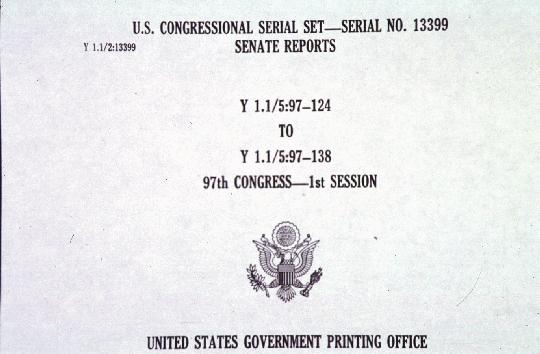
In order to further reduce the cost of preparation of the Congressional Serial Set, and because many libraries were having space problems, the Serial Set Committee recommended that the Set be offered to Depository Libraries and International Exchange libraries in microfiche format as well as the bound format beginning with the 96th Congress. To provide flexibility in filing and to increase the usability of the microfiche set, only one Document or Report would be put on a piece of fiche. Also, Documents and Reports would be filmed as soon as they were issued and sent to those libraries that chose to receive the microfiche. In order to turn this myriad of microfiche into the microfiche edition of the United States Congressional Serial Set, dividers and a single fiche containing the Title Page and/or Table of Contents for each volume is provided at the end of the Congress.
Prior to offering the Serial Set in microfiche our total binding count was nearing 1000 copies. By offering the Set in microfiche our total binding count was reduced by half.
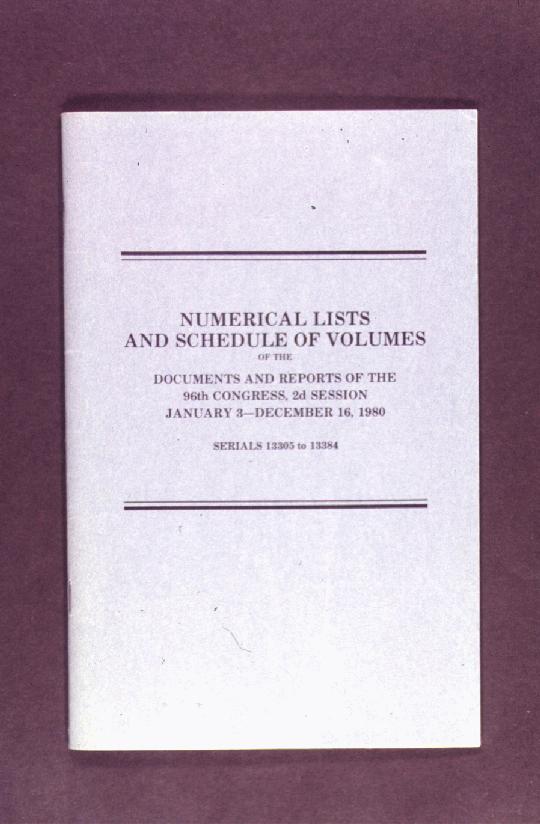
Another recommendation of the Serial Set Committee was that the Numerical List and Schedule of Volumes, which is one of the principal finding aids for material bound in the Congressional Serial Set, should be combined with the Monthly Catalog of U.S. Government Publications. The consensus of opinion was that the volumes of the Serial Set should have "full cataloging" in the Monthly Catalog. As a result of this recommendation, the Joint Committee on Printing directed the Government Printing Office to combine the Numerical List and Schedule of Volumes and the Monthly Catalog, beginning with the 97th Congress.
The Numerical List lists numerically, with a brief title, all of the Senate and House Documents and Reports issued during a Session of Congress
Publication, Access, and Transformation
The Numerical List also indicates the specific volume of the Congressional Serial Set in which each Document and Report is bound. No alphabetical or subject indexing is contained in this publication.
The "Schedule of Volumes" lists numerically, by Serial Number, each volume of the Congressional Serial Set as well as the contents of each volume. The Schedule of Volumes is usually planned at the beginning of a new Session of Congress and it is compiled as the Session of Congress progresses. All documents authorized to be printed during the Session must be submitted for printing or accounted for before theThe Congressional Printing Management Division of the Government Printing Office is now responsible for the preparation of the "United States Congressional Serial Set." Prior to October 1983, the responsibility was under the Superintendent of Documents. Schedule can be completed.
A new publication entitled, "Monthly Catalog--United States Congressional Serial Set Supplement" came off the press in March 1985. It indexed all of the Documents and Reports of the 97th Congress that were bound in the Serial Set and included a "List of the Serial Set Volumes." Three-fourths of the publication consisted of various indices and the Numerical Listing of Documents and Reports was omitted, much to the dismay of the users.
Based on user response, the Serial Set Committee was asked to meet again to review this new publication and to make further recommendations for changes in the 98th Congress Catalog.
After much deliberation the Serial Set Committee made the following recommendations:
- That the publication should be independent from the Monthly Catalog of U.S. Government Publications.
- That the title should be changed to "United States Congressional Serial Set Catalog: Numerical Lists and Schedule of Volumes" to more accurately reflect the purpose and contents of the Catalog.
- That the "Numerical Listing" and the "Schedule of Serial Set Volumes" should be a permanent part of the Catalog.
- That the "Schedule of Serial Set Volumes" should be published in Administrative Notes in Preliminary Form as soon as possible at the end of the Congress, prior to being printed in the Catalog.
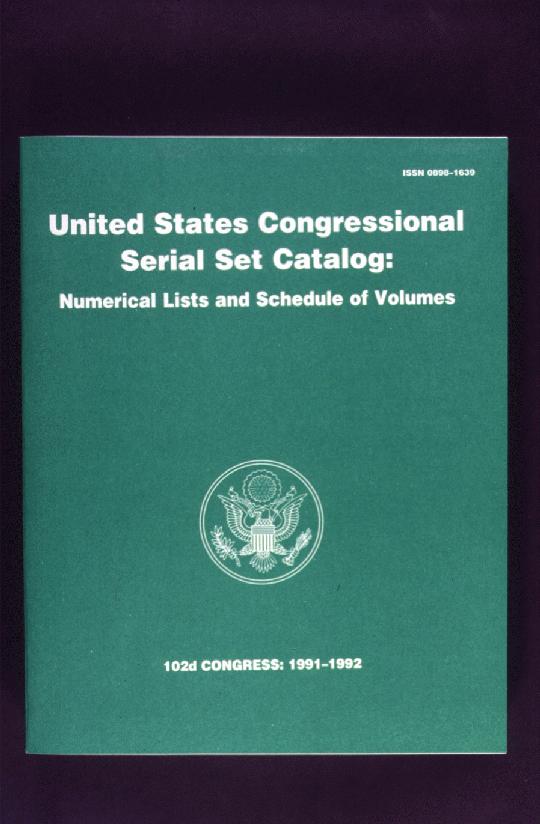
Thus, the present publication entitled "United States Congressional Serial Set Catalog" evolved and was issued, indexing Congressional Serial Set material for the 98th Congress.
Libraries who have selected the bound Serial Set should have also selected Item 0557-A or 0557-B to receive the Serial Set Catalog in either paper or microfiche.
It is not possible to publish the Congressional Serial Set Catalog immediately following the sine die adjournment of a Congress, as there are still many loose ends to be pulled together. However, the Catalog will be issued for each Congress in as timely a manner as relative circumstances will permit.
The Congressional Serial Set contains comprehensive and detailed information on a wide range of subjects. It is a useful reference source for genealogical and biographical research.
The documents which comprise the historic United States Congressional Serial Set are literally the "heritage of our Nation." The Serial Set will always be a valuable reference tool for determining the legislative intent of the statutes after their enactment by Congress.
In this day of electronic technology, I see a real need for continuing input from librarians and historians regarding the preservation of historical documents. The Government Printing Office appreciates your continued input on this important matter.
This is the end of my presentation on the U.S. Congressional Serial Set. I trust that I have enlightened you as to its beginning and to its evolvement through the years.
Definitions
Reports - (Senate & House)
Reports of Congressional Committees concerning proposed legislation and/or contain findings on matters under investigation.
Senate Executive Reports
Reports of the Committee on Foreign Relations relating to Treaties between the United States and foreign nations which have been submitted to the U.S. Senate for ratification, or are reports of various Senate Committees regarding nomination of individuals.
Senate Executive Documents
Reports of the Committee on Foreign Relations relating to Treaties between the United States and foreign nations which have been submitted to the U.S. Senate for ratification, or are reports of various Senate Committees regarding nomination of individuals.
Senate Treaty Documents
Contain the text of a Treaty as it is submitted to the U.S. Senate for ratification by the President of the United States. Numbered consecutively from the 1st Session through the 2d Session of a Congress. Prior to the 97th Congress known as Executive (Lettered) Documents, and identified by letters of the alphabet
Documents - (Senate & House)
Contain various other materials ordered printed by both Houses of Congress. Documents can include reports of Executive Departments and Agencies, some of which are submitted in accordance with Federal law, then later are ordered printed as Documents. Sometimes Committee Prints are ordered printed as Documents also, if the information they contain is in demand. Documents have a larger distribution than Committee Prints.
Note:
Senate Executive Reports, Senate Executive (Lettered) Documents, and Senate Treaty Documents are synonymous to the U.S. Senate only, since all Treaties must be ratified by the Senate and all nominations must be confirmed by the Senate.
All of the above numbered Documents and Reports begin with No. 1 at the beginning of the Congress and they are numbered consecutively from the 1st Session through the 2d Session of a Congress.


